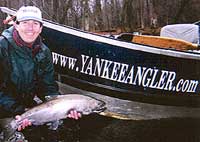Fly Presentation Technique ~
Detecting the Take and Proper Weighting
by Randy Jones 
There are numerous ways to present a fly with a fly rod for steelies. This is one of the more popular methods used in the Great Lakes region. Many well know fly fishing authors have written about it. My good friend Tom Rosenbauer mentions it in his Orvis fly fishing technique book.
Deep nymphing, dead drifting, drift fishing, high sticking, chuck and duck. These are all terms I've heard, used to describe the same method. Anytime you can make it easier for any species of fish to feed anywhere in the world you will increase the odds of hooking up. That's why this presentation technique is so popular, especially during the winter months. It works in every condition you will ever find on a river. (High-low water, cold-warm water, any species, clear-off color water, fast-slow moving water, close in far out, no room for a back cast, crowded conditions, etc. ...).
You only want to lightly tap your weight on top of the rocks (3 light ticks is sufficient), giving your rod tip a slight bounce or 3-6 inch twitch when feeling a slight pause, stop or hesitation. If you slightly twitch the tip of the rod on the pause, then you are pre-setting correctly. If it's a rock, you have just gotten over it, and kept your fly on the bottom. If you fully set, then a lot of the time you have moved your weight and fly so far off the bottom that your drift is over. If it's a fish (rock?) then your line will not move and stop which means you should immediately set the hook. I pre-set the hook with a twitch, then set, if line remains still.
The first lesson I was ever taught when fishing for steelhead or salmon using this technique is if you pre-set on the pause or hesitation, and pull up a leaf, then you are detecting the slight pause or hesitation correctly. If you wait every time for your line to stop before you set, then you are missing fish. I always tell my clients - when in doubt, pre-set the hook, and if the line doesn't move, PLEASE (politely) set it!
Not a day goes by when you can watch other anglers fishing and see their line pause with no reaction by them. Or watch the line stop dead for 3-4 seconds with no reaction. The reaction to the take has to be immediate or fly is spit out.
Here are several ways to help you detect subtle takes:
-
Watching the line in the water as it moves down stream on the drift. You will normally always see it before you feel it.
-
Feeling with your rod hand on cork.
-
Lightly touching your rod hand index finger to the line.
-
Holding the line in your other hand. The line should be held in your fingertips for greatest sensitivity.
-
There are some seasoned steelhead anglers who don't watch their line in the water on the drift. Instead they look at their rod tip through the entire drift, letting the slight movement of the tip tell them what is going on underneath the surface.
Another take that not everyone is aware of is 2 or 3 quick taps in a row. I always tell my clients that if they feel 2-3 quick taps, set on it. If you stop to think about what you just felt, then it's too late. You've just missed one of the easiest ways to determine a take.
Proper Weighting:
I sometimes change my weight 2-3 times without moving from the same spot. I work the water close, then farther out. Weighting is critical to helping you detect the takes. The key is to lightly tap the bottom, not dredge the bottom. Too much weight and detecting subtle takes is impossible.
This technique also works in your local streams and rivers for trout during high water conditions. It also works in the deeper, faster sections where traditional fly lines will not allow you to get down to the bigger fish.
Basically, telling the difference between tapping a rock and a subtle take is one of the most difficult skills to acquire when fishing in this manner.
Besides all the other pieces of the puzzle we have covered and will cover, hopefully these tips will help you all to be more in tune with your drift fishing. Putting all of this together consistently will put you into the 10% that catch 90% of the fish!
Happy Hookin!
Randy Jones

Randy Jones is a thoroughly proficient and professional full-time fly / spin fishing guide with 18+ years of fresh and saltwater experience. He has represented Orvis Corporation as a guide (18 years) and chief instructor of their 2-1/2 day Saltwater Fly Fishing schools. During the summer, Randy can be found guiding the Monomoy Island area (Cape Cod) where sight fishing on the flats for Trophy Striped Bass is his specialty. During the Fall, Winter and Spring Randy runs a drift boat and wade trips on the World Class Salmon River in upstate N.Y. for Steelhead, Coho, Browns, Atlantics and Kings. Visit his award winning web site at www.YankeeAngler.com.
Content © Randy Jones
Formatting © 2000 FishUSA.com
All Rights Reserved